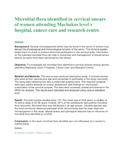MICROBIAL FLORA IDENTIFIED IN CERVICAL SMEARS OF WOMEN ATTENDING MACHAKOS LEVEL V HOSPITAL, CANCER CARE AND RESEARCH CENTRE.
Abstract
Background: Several microorganisms which may be found in the cervix of women may disrupt the physiological and immunological function of the cervix. The immune system keeps them on check to prevent abnormal proliferation in the cervical walls. Information on the selected microbial flora can help in prevention and management of precancerous lesions as some have been perceived as risk factors.
Objective: To investigate the microbial flora identified in cervical smears among women attending Machakos Level V Hospital, Cancer Care and Research Centre.
Material and Methods: This was across-sectional descriptive study. It involved women who were at their reproductive age and consented to participate in the study voluntarily. The study data collecting tool was a preformed questionnaire. The required variables were age, salient features on clinical assessment and findings on microscopic examination of the cervical scrapes. The data were screened, pooled and entered in the SPSS for analysis. The results were tabulated and analyzed using various statistical tools.
Result: The total number studied were 176. The mean age of 40.6 years, a median of 43 and a range of 22-58 years. Overall, 38 % of the participants had positive microbial flora outcomes. Microbial flora was distributed in all age groups. Candida species was the most commonly observed pathogen while Actinomyces was the least observed microorganism in this study. Marital status and cytological features had no influence on microbial flora identified (p >0.005).
Conclusion: In this study microbial flora identified was not influenced by a woman’s marital status.
Collections
- Gold Collection [1026]

